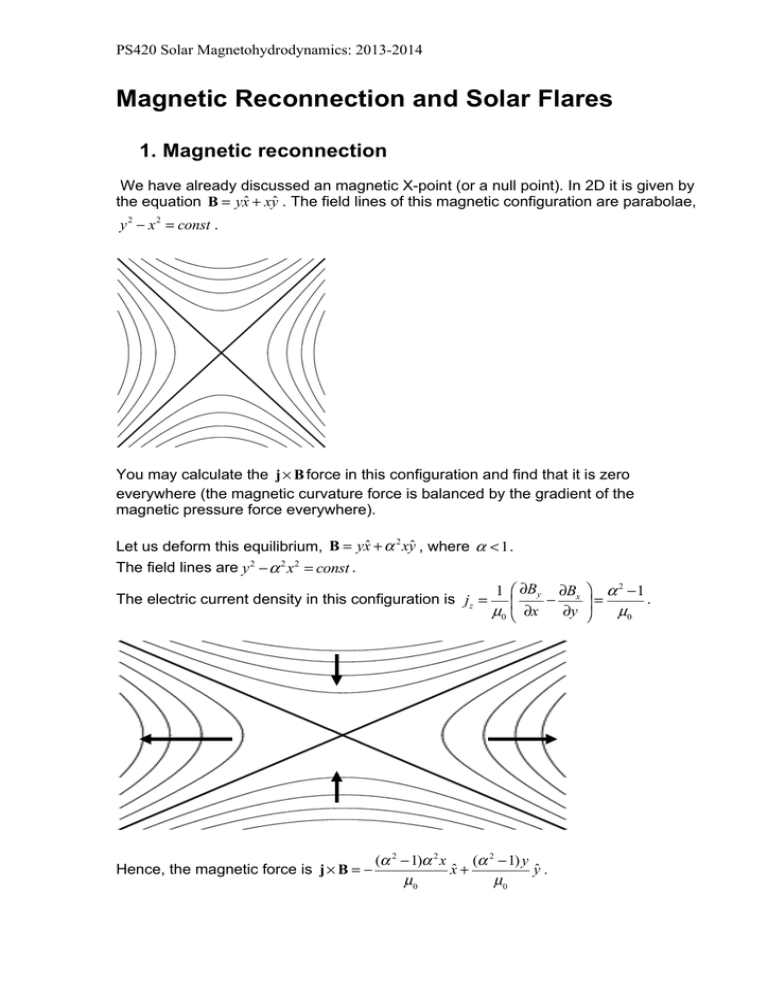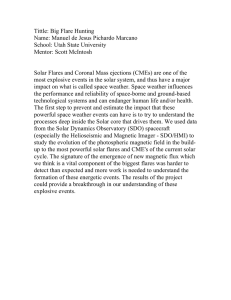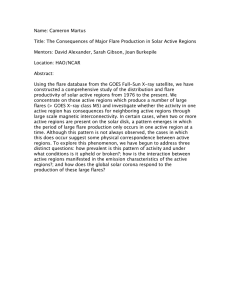Magnetic Reconnection and Solar Flares 1. Magnetic reconnection
advertisement

PS420 Solar Magnetohydrodynamics: 2013-2014 Magnetic Reconnection and Solar Flares 1. Magnetic reconnection We have already discussed an magnetic X-point (or a null point). In 2D it is given by the equation B = yx̂ + xŷ . The field lines of this magnetic configuration are parabolae, y 2 ! x 2 = const . You may calculate the j ! B force in this configuration and find that it is zero everywhere (the magnetic curvature force is balanced by the gradient of the magnetic pressure force everywhere). Let us deform this equilibrium, B = yx̂ + ! 2 xŷ , where α < 1 . The field lines are y 2 − α 2 x 2 = const . The electric current density in this configuration is jz = Hence, the magnetic force is j ! B = " 1 ⎛ ∂By ∂Bx ⎞ α 2 − 1 . − ⎜ ⎟= µ0 ⎝ ∂x ∂y ⎠ µ0 (! 2 "1)! 2 x (! 2 "1) y x̂ + ŷ . µ0 µ0 PS420 Solar Magnetohydrodynamics: 2013-2014 Let us calculate the values of the force at different points: ! 2 !1 ! 2 !1 j ! B (0,1) = ŷ, j ! B (0,!1) = ! ŷ, µ0 µ0 (! !1)! =! 2 j ! B (1,0) µ0 2 (! !1)! = 2 x̂, j ! B (!1,0) µ0 2 x̂. Thus, the configuration is not in equilibrium. If an X-point is perturbed, the perturbation grows. The forces generate flows of the plasma. If η ≠ 0 this leads to reconnection of the magnetic field lines: the lines are brought by the inflows to the X-point and are moved away by the outflows. A similar phenomenon can happen in a current sheet: The Sweet – Parker stationary solution. The plasma diffuses into the current layer at some relatively small inflow velocity vi . (More specifically: there is the total pressure balance across the current sheet; in the vicinity of the current sheet there are large gradients of the field and hence diffusion; the total pressure outside the current sheet is getting higher, resulting into a pressure gradient force, moving field lines toward the current sheet). PS420 Solar Magnetohydrodynamics: 2013-2014 In the current sheet the oppositely directed magnetic field lines get reconnected, resulting into the magnetic tension forces in the horizontal direction. These forces drive the frozen-in plasma – sling shot effect. The plasma is accelerated along the layer, and eventually expelled from its ends at some relatively large velocity v0 . What does accelerate the plasma? Let us neglect the gas pressure, !p = 0 , and consider only stationary reconnection, ! / !t = 0 . The Euler equation gives us ! ( V.!) V = j " B. For the x-component of the equation we get ! ( V.!)Vx = ( j " B) x = ( 1 % $ B2 # + ( B.!) Bx * . ' µ & $x 2 ) !Vx By !Bx " . !x µ !y Making an order-of-magnitude estimation (see the sketch above for the geometrical scales) we get V2 B B ! o ! o i. L µ" The conservation of mass and the assumed incompressibility of the plasma give us ! / L = Vi / Vo , or Bo / Bi = Vi / Vo (here we used that Bi ,Vi = Bx ,Vy and Bo,Vo = By ,Vx , see the sketch, and that the frozen-in condition is fulfilled everywhere except the small region of reconnection shown by the dark bar in the sketch). Hence, we get B BL B BB Vo2 ! o i = o i i = CAi2 µ!" µ! Bo Along centre of diffusion region: Bx = 0, !By / !x " 0. It leaves !Vx where C Ai is the Alfven speed. The rate of magnetic reconnection is defined as M 0 = vi / v0 ! S !1/2 , where S = µ0 LCA / η is the Lundquist number (c.f. with the Reynolds number). According to the Sweet – Parker model, the magnetic reconnection takes place on the hybrid time scale τ 1/A 2τ 1/R 2 , where the first factor is the Alfven transit time across the current sheet and the second factor is the time of the resistive diffusion across the plasma. Typically, in the corona S ≈ 107 −9. This gives the characteristic time of reconnection to be about a few tens of days. This is too long to explain dynamical phenomena in the solar atmosphere. PS420 Solar Magnetohydrodynamics: 2013-2014 There have been several methods suggested to speed this process up: the Petchek reconnection based upon the assumption that the inflows form shock waves, anomalous resistivity, etc. The problem of “fast reconnection” is one of the key problems of modern solar and space plasma physics. Energy conversion in magnetic reconnection: The input energy is the energy stored in the magnetic field, . Change of B because of reconnection generates steep gradients of B, hence increase in ! " B . This leads to the increase in the current density. As the diffusivity is not negligible in the reconnection region, it is subject to Ohmic dissipation, hence increase in internal energy of the plasma. Also, the slingshot effect generates bulk flows of plasma, hence increase in its kinetic energy. The electric field E = !V " B accelerates plasma particles: non-thermal high energy particles. PS420 Solar Magnetohydrodynamics: 2013-2014 2. Solar Flares Classification of solar flares: Hα classification Radio flux at 5000 Importance Area Area MHz in Class (Sq. 10-6 solar s.f.u. Deg.) disk S 2.0 200 5 1 2.0–5.1 200–500 30 2 5.2– 500–1200 300 12.4 3 12.5– 1200– 3000 24.7 2400 4 >24.7 >2400 3000 Soft X-ray class Importanc Peak flux e class in 1-8 Å w/m2 A B C 10-8 to 10-7 10-7 to 10-6 10-6 to 10-5 M 10-5 to 10-4 X >10-4 PS420 Solar Magnetohydrodynamics: 2013-2014 Composite energy spectrum from a large flare: And its interpretation: PS420 Solar Magnetohydrodynamics: 2013-2014 There is a relation between the soft X-ray flux (thermal emission) and hard X-ray and microwave fluxes (non-thermal emission): the Neupert effect. The Neupert effect simply notes that the hard X-rays occur during the rise phase of the soft X-rays. The time derivative of the soft X-ray light curve resembles the hard X-ray light curve. PS420 Solar Magnetohydrodynamics: 2013-2014 The standard model of solar flare: 1. Magnetic free energy is stored in the corona, due to either motions of the photospheric footpoints of loops or to the emergence of current-carrying field from below the photosphere. 2. A cool, dense filament forms, suspended by the magnetic field, over the neutral line. 3. The field evolves slowly through equilibrium states, finally reaching a nonequilibrium which causes the closed field to rise and erupts outward. 4. The reconnection of the field below the rising filament provides plasma heating and particle acceleration that we call the flare. 5. The accelerated particles follow the field lines and interact with the chromosphere, heating it and causing the evaporation upflows of the plasma. 6. “Post-flare loops” are formed over the neutral line; they gradually cool down by radiation. 7. More field lines are involved in reconnection; the reconnection site is going up, forming new post-flare loops situated above the previously created ones. 8. A multi-temperature arcade is formed with “older” cooler loops being below “new” hotter loops. PS420 Solar Magnetohydrodynamics: 2013-2014 An observational “illustration” of this structure in soft X-ray: PS420 Solar Magnetohydrodynamics: 2013-2014 Red: UV continuum Blue: 171 Å pass band, ~1 MK Green: 195 Å pass band, >1.5 MK Possible scenario of a solar flare: (From Takasaki et al., The Astrophysical Journal, 2004) PS420 Solar Magnetohydrodynamics: 2013-2014 Statistics of solar flares (from Aschwanden 2004): The power law distribution: The flare frequency f against energy E: f(E) = E0 E-a The total heating rate released by all flares: where PS420 Solar Magnetohydrodynamics: 2013-2014 Evaluating the integral, obtain Typically: If a<2 – the bulk of heating is delivered by large events. If a>2 – the bulk of heating is delivered by small events. Coronal heating by flares: Active regions: Quiet Sun: Predicted frequency distribution that fulfil the heating requirement PS420 Solar Magnetohydrodynamics: 2013-2014 The detected radiation of the EUV and SXT nanoflares roughly corresponds to a third of the total coronal heating requirement. PS420 Solar Magnetohydrodynamics: 2013-2014 Variation of the emitted X-ray flux with solar cycle: Correlation of emitted X-ray flux with sunspot numbers:



